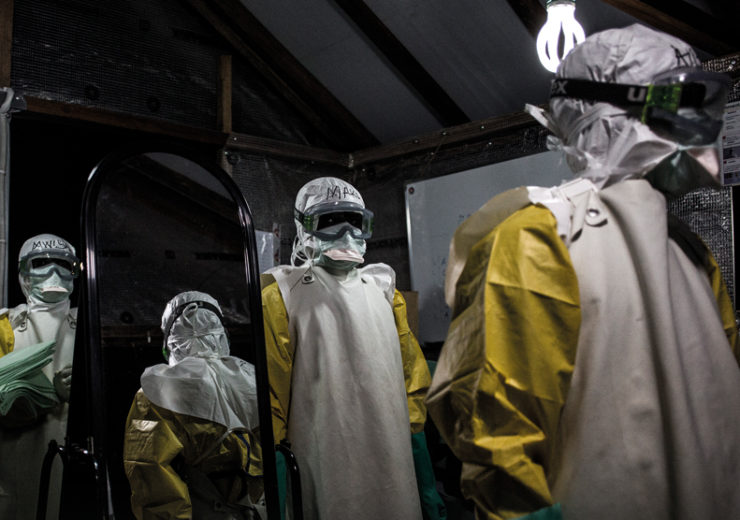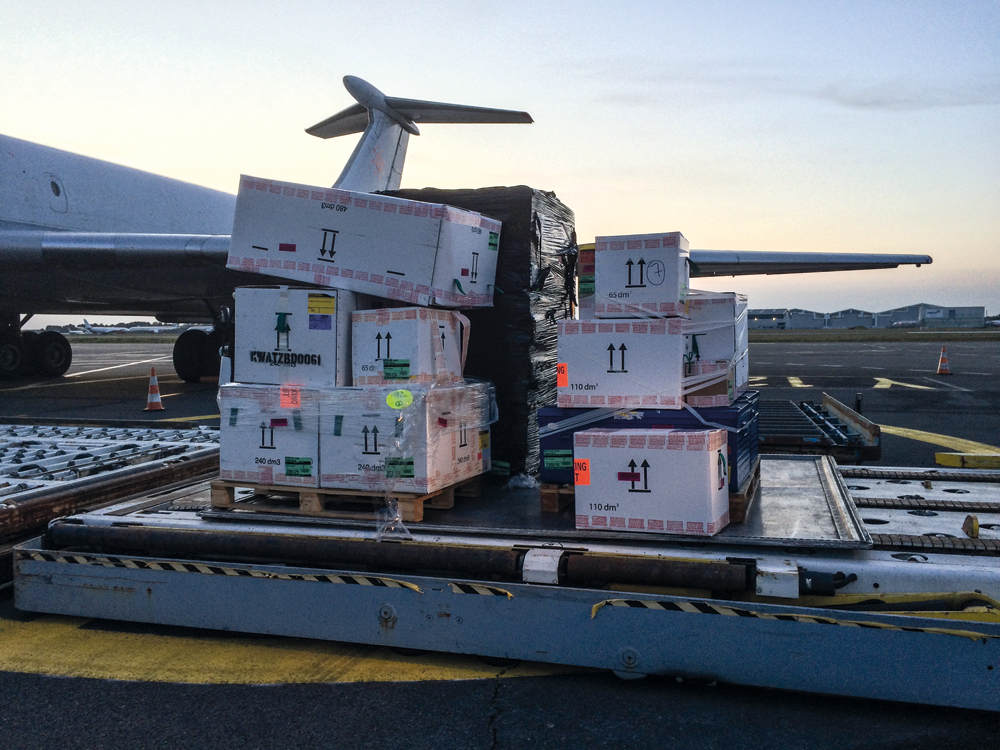The experience of adapting to new challenges for the cold chain may well prove vital when pharmaceutical companies begin to distribute what is likely to be a temperature-sensitive COVID-19 vaccine

MSF has been actively fighting the Kivu Ebola epidemic since it began to spread through urban communities and isolated areas in the DRC in 2018 (Credit: John Wessels/MSF)
As the global pharmaceutical cold chain responds to coronavirus — a pandemic unprecedented in its history — Tim Gunn speaks to Marco Gaudesi, head of GDP and cold chain at Médecins Sans Frontières, and Simon White, Pfizer’s director for global quality support, about what they’ve learned from protecting the cold chain through crises in low-infrastructure regions and developing countries.
Marco Gaudesi is a medical logistician for our times. Prior to joining Médecins sans Frontières (MSF), where he is now the head of GDP and cold chain, he divided his pharmaceutical studies between the front of the classroom and the back of an ambulance. Hurtling between emergencies as a volunteer technician, he began to formulate questions that very few researchers before him had thought to ask.
“I started to ask myself, ‘What happens with the pharmaceutical products that are used for these rescues?’” he recalls. “Somehow there is still not much standardised, focused attention on the use of products in unconventional circumstances, but it’s so important that we focus on the quality of the supply chain if we really want to focus on the quality of healthcare.”
As some of the world’s most mature healthcare systems scrabble to get enough sedatives, painkillers and muscle relaxants to manage the greatest emergency they’ve faced for over a century, Gaudesi’s emphasis on the unconventional is beginning to look more prescient than he ever feared. There was a time when MSF’s focus on making its temperature-controlled packaging materials and data-loggers reusable seemed relevant only for isolated, low-infrastructure disaster zones in countries like Haiti, Sudan and the Democratic Republic of Congo (DRC). At the time of writing, however, medical professionals in Europe and the US are putting single-use N95 masks in ovens to try and decontaminate them between shifts.
That particular issue isn’t the pharmaceutical industry’s to solve, but with numerous supply chains already stretched and much of the world fixated on the race for a COVID-19 vaccine, its ability to deliver rapid results while conforming to quality assurance requirements and good distribution practices is about to be tested like never before. A recent Centers for Disease Control and Prevention (CDC) estimate suggests that $300 million of vaccines are destroyed each year due to improper storage and transportation. Should similar issues impact the supply of novel coronavirus vaccines, or worse, endanger patients, the industry could face a monumental backlash.
With that urgency in mind, it is strategies refined for dealing with the sort of exceptional challenges posed by Ebola in West Africa and cholera in post-earthquake Haiti, or simply in regions that pose greater than usual risks for temperature-controlled medicines, that have the most to teach us about the coordinated response needed today.
As Gaudesi is quick to point out, that doesn’t mean cutting corners. “What often surprises pharmaceutical companies is that we do not accept donation medicines,” he explains. “First, that’s for our independence, but we want to ensure the highest possible quality and a good shelf life for products, so we do not improvise on procurement. We wouldn’t use any product that wouldn’t be used in a hospital in Europe.”
On the other side of that decision are companies like Pfizer. But Simon White, its director for global quality support and supply chain quality, is clearly of the same opinion as Gaudesi. When donating supplies to aid agencies like Unicef, White points out that, “ultimately, it’s the Pfizer label on the box, and if there’s an issue, it’s going to be Pfizer that has to face the outcome, the implications and the consequences.”
That means Pfizer is as stringent with aid agencies as it is with any other distribution partner. “It’s equally important to us that groups like Unicef have supply channels with the right elements of quality control,” White continues, “so we’ll set up quality agreements with those partners and make sure that they have the right measures in place for that particular route to ensure product quality.”
Implemented correctly, those measures save lives. In May 2017, improperly stored measles vaccines killed 15 children under five in the town of Kapoeta, South Sudan.
But for all that’s exceptional about the humanitarian disaster responses White and Gaudesi are discussing, there is a clear overlap with traditional market development. Indeed, as far as the conventional cold chain goes, the pharmaceutical market is becoming ever more globalised, with lanes through new difficult environments opening every year.
That experience of adapting to new challenges may well prove vital when pharmaceutical companies begin to distribute what is likely to be a temperature-sensitive COVID-19 vaccine, just as the lessons learned from this crisis have the potential to improve and accelerate the process of delivering other state-of-the-art medicines to patients all over the world.
The same approach across distribution of medicines
Indeed, for White, operational consistency is the key to reliable temperature-controlled logistics, no matter the context. “We have a common approach for temperature control in distribution of the medicines, wherever they’re going worldwide,” he explains. “And I think it’s quite interesting to raise the fact that this doesn’t really only apply to the cold chain. The controlled room-temperature chain is just as important and in extreme cold or extreme heat, keeping a product at 15–25°C is just as challenging as 2–8°C, so we have the same approach to both those temperature ranges.”
For Pfizer – which, like most pharmaceutical companies, does not own distribution fleets – this consistency can only be achieved through close collaboration with service providers, all coordinated through a rigorous system of audit and quality oversight. Pfizer’s subject matter experts in the fields of temperature control and logistics act almost as consultants in these relationships. Auditors, meanwhile, ensure partners and providers correctly validate containers and equipment, which, as far as possible, need to be the same across different areas of operations, synergising the aforementioned benefits of consistency with those of scale.

Though MSF takes a similar approach to quality assurance, it actually operates as if it were its own client. “Our supply chain is very particular because it’s really end-to-end,” explains Gaudesi. “We purchase from manufacturers in most cases, and we deal with the whole supply chain up to the patient.”
That supply chain is based on three European supply centres (registered as wholesalers) in Brussels, Amsterdam and Bordeaux. The Brussels centre alone supplies millions of doses of vaccine every year, which are usually transferred to regional hubs in Dubai and Nairobi on the way to in-country pharmaceutical warehouses. That’s where the journey gets difficult. “The contexts where we work have very limited infrastructures, which physically create very technical cold-chain challenges when our last mile might be a thousand miles,” says Gaudesi.
The example he repeatedly returns to is the ongoing fight against the Ebola epidemic in the North Kivu region of the DRC, which is thousands of kilometres from the pharmaceutical warehouses in the capital, Kinshasa. For only the second time in history, this outbreak is being contained through a ring vaccination programme, primarily using Merck’s rVSV-ZEBOV (Ervebo), which was employed under a compassionate use protocol prior to being licensed for use in Europe and the US late last year. With the WHO reporting 97.5% effectiveness at stopping Ebola transmission relative to no vaccination, the only issue with rVSV-ZEBOV is its temperature sensitivity. It must be stored between -70°C and -80°C.
“It’s already challenging to deal with such a product in Europe, but just imagine the complexity for this temperature range in a remote village in the DRC,” says Gaudesi. “An entire cold chain needs to be set up – active and passive.”
Again, that doesn’t mean improvised procurement, but an emphasis on simple and effective technical solutions. Though it is not strictly required to, MSF standardises all of its equipment according to the WHO’s performance, quality and safety process, as well as using its own internal procedures and protocols to protect the cold chain and ensure GDP compliance for supply chains that cross borders between markets that do not have their own quality agreements.
Pfizer approaches these issues from the other direction, working with other pharmaceutical companies to advise national and international regulators and health authorities on how to maintain the appropriate oversight of pharmaceutical wholesalers, distributors and logistics companies.
For its part, the DRC instituted national GDP guidelines in 2015, but they don’t make MSF’s ‘last mile’ between Kinshasa and North Kivu any less hazardous.
“The differences with our technical solutions for cold-chain storage often come down to unreliable energy networks, which means we can only rely on generators and solar energy in most cases,” explains Gaudesi. As such, MSF makes far greater use of ice-lined active cold-chain refrigeration equipment than counterparts that operate on lower risk lanes. These fridges incorporate ice layers that can guarantee a continued passive ‘cold-life’ during power cuts. It also eschews phase-changing material (PCM) and other technologies based on reverse logistics in favour of more traditionally reusable ice packs.
“PCM is quite difficult to condition and also not really sustainable for us, because we cannot guarantee that it can be reused,” says Gaudesi. “The key is to have equipment that is reusable and user-friendly, so the packaging we use to ship a product to a hub in a developing country can be reused for the last mile.”
This emphasis on mapping out opportunities to use the same equipment and materials in different contexts fits neatly with Gaudesi and MSF’s commitment to emergency preparedness. In fact, the more than 20,000 different product lines in the NGO’s supply centres are largely organised into pre-qualified kits tailored for specific needs.
“We have a kit, for instance, to respond to a need to vaccinate, I don’t know, 10,000 beneficiaries for a campaign in South Sudan,” says Gaudesi by way of example. “We have already stored the tanks and generators to ensure the power supply for the active cold chain, as well as passive cold-chain equipment and monitoring devices. Everything is already prepared according to the highest possible standards offered by the market and it can be actually deployed in the shortest possible time even in remote areas because we already previewed the scenario.”
Ready for anything as coronavirus pandemic rages

Although the core of any vaccination campaign is obviously the pharmaceutical product, much of the work MSF does around that is beyond the scope of the industry itself. Even so, Gaudesi points out that the research and development that makes the charity’s disaster relief operations possible could well help companies looking to get ahead of their competitors in developing markets.
“The market does not always offer solutions,” he says simply. “In order to ensure quality for a larger-scale pharmaceutical supply chain in remote areas and developing countries, the sector will have to work on the specifics of isothermal packaging and temperature control.”
The same crossover is evident from the fact that both Gaudesi and White extol the value of developing technologies like remote temperature control and satellite tracking for managing cold-chain operations in high-risk environments and emerging markets. Taking a shipment from Antwerp, Belgium to Abidjan, Côte d’Ivoire as an example, White points out how attention to temperature data at different stages already helps Pfizer to optimise logistics in the present and introduce medicines with different temperature requirements in future.
But as today’s cold chain faces up to a global pandemic, the industry needs to look to those most experienced in confronting crises. “We manage excursions just like the industry does,” says Gaudesi, “but for us, it’s not just a shipment to the suppliers, but to a team that needs to know if it can use a vaccine ASAP. A temperature deviation does not represent simply a loss of money; it might turn into a life-saving emergency.” We don’t need any more of those right now.
This article originally appeared in Volume 1, 2020, of World Pharma. The full issue can be viewed here.
